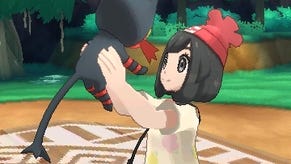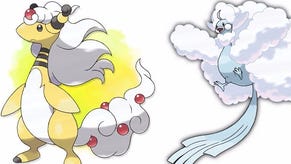Pok¨Śmon Sun and Moon IVs explained - how to judge Pok¨Śmon stats and get max, 31 IVs in HP, Attack, Defense, Special Attack, Special Defense and Speed IVs
Everything you need to know about the hidden stats behind every Pok¨Śmon.
Pokémon IVs, or Individual Values, are very gradually becoming more openly recognised within the games themselves, as well as the wider community.
The hidden stats which udnerpin a given Pokémon's proficiency in battle are a hugely important element to the competitive battler, but within the more casual, day to day battling of those who stick the main story, there's still something of an air of mystery around them.
So how do IVs work, and how does the IV judge work in Sun and Moon, for those who want to know? We'll be explaining everyting you need to know about Pokémon IVs, for trainers of all levels, here in this guide.
For more on competitive Pokémon meanwhile, head back to our main Sun and Moon competitive training guide, or take a look at our pages on Sun and Moon EVs and the best EV training locations, Breeding and how to pass on Egg Moves, IVs, Abilities, Natures, and Poké Balls, and our explainer on the best way to farm Bottle Caps and Hyper Training.
Note that, as of Pokémon Ultra Sun and Ultra Moon's release, we're still updating this page to double check all of the below methods work. In theory though they're all the same - so don't expect many changes!
Pokémon Sun and Moon IVs - hidden stats, 31 IV numbers and the IV Judge in Ultra Sun and Ultra Moon
The hidden-stat, lots-of-numbers-where-do-I-start thing surrounding IVs as a whole can be a little indimidating. Do you want 6 IVs, or 31 IVs? What's the difference between IVs and base stats? And what about EVs? And don't Natures affect them too?
Well, that's what we're here to explain. Let's start with some definitions of all the things that could affect a Pokémon's stats:
- Base Stats - the standard numbers which differentiate two Pokémon species. All Alakazam, for example, have a base 120 Speed, whilst all Machamp have a base 55 Speed.
- IVs (Individual Values) - the hidden numbers which dictate why one Pokémon has better or worse stats than another of the same species. So why one Alakazam, for example, could be faster than another.
- EVs (Effort Values) - another hidden number which dictate's a Pokémon's final stats. EVs are points which are accumulated in a given stat through EV training, which is usually done by defeating other Pokémon in battle. If two Alakazam have the same IVs, and all other things were equal, one could still be faster than the other if it were EV trained in Speed.
- Natures - Each Pokémon has a Nature, of which there are 25 different kinds. Most of these Natures boost a certain stat by 10 per cent, and inhibit another stand by 10 percent. Two Alakazam which are equal in IVs and EVs could still differ in move order if one were to have a Timid Nature, for example, which boosts Speed.
Let's burrow down a little more into IVs. Individual Values are essentially a Pokémon's inherited genes. Think of a species of Pokémon like you would a species of animal: horses are generally faster sprinters than cows (you could say they have a higher Base Stat for Speed), but some horses are born faster than others (because some have higher Speed IVs than others). EVs, meanwhile, work like training - you could have an untrained horse that was born fast and an untrained horse born slow, and the naturally fast horse would win. But train the naturally slow horse, and it might be as fast, or faster, than the untrained, naturally speedy one.
In Pokémon Sun and Moon - and the previous mainline games - the IVs themselves are measured with a score from 0 to 31. If my Alakazam's Speed had 0 IVs, it would, barring a detrimental Nature, be the slowest Alakazam possible. If it had 31 IVs in Speed it would be the fastest Alakazam possible, barring one with a beneficial Nature.
Some quick numbers to illustrate that example then, using Alakazam's Speed still:
- Alakazam Base Speed - 120
- Alakazam Speed at level 100 with 31 IVs, no EV training, and a neutral Nature - 339
- Alakazam Speed at level 100 with 0 IVs, no EV training, and a neutral Nature - 245
All things being equal then, you can see the huge difference beneficial IVs make to a Pokémon at the top level. When it comes to competitive battling meanwhile, on almost every occasion you're going to want what's known as a 6IV Pokémon - one that has the maximum 31 IVs in all six of it's stats - HP, Attack, Defense, Special Attack, Special Defense and Speed.
Some exceptions do occur however. The move Hidden Power, which is often useful when building teams for the metagame, changes it's type according to a Pokémon's IVs, so it might be beneficial for one to be lower than another. Likewise, damage from the Confused status effect is based on a Pokémon's Attack stat, so if your Pokémon is a Special Attacker - like Alakazam is - it's actually beneficial to have as low an Attack stat as possible.
Finally, there are special moves, like Trick Room - which reverses certain stats - and strategies based around them, so you may want to curate your Pokémon's IVs around that too.
Generally speaking though, a 6IV Pokémon is the best you can get, and getting a 6IV Pokémon is already plenty to worry about for beginners. That's because the odds, of course, are incredibly low when it comes to catching one at random - 31 different possible values in six different stats means the odds run into the millions.
Fortunately however, there are a few ways to narrow those chances right down, by far the most efficient of which being a shortcut we highlight in our guide to Pokémon Sun and Moon Bottle Cap farming and Hyper Training.
Hyper Training, as we explain in the above guide, is technically superficial - it boosts IVs for battling purposes, but doesn't actually change the IVs themselves, meaning things like Hidden Power and the stats passed on through breeding remain unaffected.
For more on Pokémon Ultra Sun and Moon, head to our main Pokémon Ultra Sun and Ultra Moon walkthrough and guide hub, which includes guides to new Ultra Sun and Ultra Moon Pokémon and Pokédex changes, the Festival Plaza, a list of Global Missions and rewards, an explainer on Pokémon Bank, a dedicated page on Pokémon Competitive Training, including IV Training, EVs and hidden stats, Breeding 6IV Pokémon explained and how to farm Bottle Caps fast for Hyper Training. What's more, we have pages on the Rockruff event for getting Dusk Form Lycanroc and, last but not least, a full Ultra Sun and Ultra Moon QR codes list for adding all Pokémon to your Pokédex.
IV Judge
Finally, you can judge your Pokémon's IVs by talking to a particular NPC in-game.
Once you've defeated the Elite Four and made your way to the Battle Tree, you'll find a sleep Ace Traininer waiting just outisde it's entrance on the right. At first, he'll be too sleepy to pay you any attention.
To snap him out of it, you need to hatch 20 Pokémon Eggs. Spotting your fondness for breeding the best Pokémon, he'll then unlock the IV Judge function in your PC, granting you the fastest IV-checking method in Pokémon games to date.
To judge a Pokémon's IVs, head to your PC box and hover the cursor over a Pokémon. Select the 'Judge' button down the bottom of the screen, and it'll bring up a screen which shows a graphic with various phrases, depending on your Pokémon's specific stat strength (IVs) and overall potential (total IVs - which is less useful). Here's what they mean:
| Judging Statement | IVs in that stat |
|---|---|
| Best | 31 |
| Fantastic | 30 |
| Very Good | 26-29 |
| Pretty Good | 16-25 |
| Decent | 1-15 |
| No Good | 0 |
For perfect IVs, which you will absolutely need in competitive play, be sure to settle for nothing less than 'Best' in any given stat!








